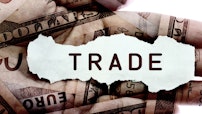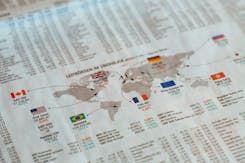Trading Tips for the FTSE 100 (Updated 2025)
All products and services featured are independently selected by WikiJob. When you register or purchase through links on this page, we may earn a commission.
61% of retail investor accounts lose money when trading CFDs with eToro. You should consider whether you understand how CFDs work, and whether you can afford to take the high risk of losing your money.
- A list of the Top Brokers for FTSE 100 for January 2025:
- Description of the Best Brokers for FTSE 100 for January 2025
- 7 Trading Tips for FTSE 100 for January 2025
- What Is the FTSE 100?
- What Is the Difference Between FTSE 100, FTSE 250 and FTSE 300?
- What Are FTSE 100 Companies?
- How Is the FTSE 100 Measured?
- What Moves the FTSE 100 Market Price?
- Frequently Asked Questions
- Final Thoughts
A list of the Top Brokers for FTSE 100 for January 2025:
- Pepperstone
- eToro
- Plus500 (CFDs)
- IG
- Saxo
Description of the Best Brokers for FTSE 100 for January 2025
1. Pepperstone
Pros
- Extensively regulated
- No minimum deposit
- Low fees and mostly free withdrawals
- Good customer service
Cons
- No investor protection for clients outside UK, EU and EEA
- Withdrawal fee for international bank wires
- CFDs only
Pepperstone offers robust trading options for the FTSE 100, one of the most widely followed stock market indices, representing the 100 largest companies listed on the London Stock Exchange by market capitalization.
Trading the FTSE 100 through Pepperstone is facilitated via Contracts for Difference (CFDs), which allow traders to speculate on the price movements of the index without owning the actual shares.
Pepperstone's platform allows traders to access the FTSE 100 index with ease, providing flexibility in trading hours that align closely with the UK market's opening times.
This flexibility enables traders to engage with the market during its most active periods, capitalizing on the highest liquidity and volatility.
Pepperstone offers competitive leverage on FTSE 100 CFDs, enabling traders to control larger positions with a relatively small amount of capital. For retail clients, leverage can go up to 1:20, while professional traders may access leverage up to 1:500, allowing for enhanced trading potential. This high leverage, however, also requires careful risk management due to the amplified exposure to market movements.
Trading the FTSE 100 with Pepperstone is supported by their advanced trading platforms, including MetaTrader 4 (MT4), MetaTrader 5 (MT5), TradingView and cTrader. These platforms are known for their user-friendly interfaces, sophisticated charting tools, and extensive range of technical indicators, which are crucial for conducting in-depth market analysis and executing timely trades. Additionally, the integration with TradingView offers powerful charting capabilities and access to a large community of traders.
Pepperstone provides tight spreads on FTSE 100 CFDs, ensuring cost-effective trading. The broker's Razor account, in particular, offers low spreads combined with a small commission fee, making it attractive for traders who prioritize minimizing transaction costs. The competitive pricing structure of Pepperstone helps traders retain more of their profits.
To assist traders in managing their risk effectively, Pepperstone offers several risk management tools, including stop-loss orders and take-profit orders. These tools are essential for setting predefined exit points, thereby protecting traders from significant losses and securing profits when the market moves favorably. Furthermore, the availability of negative balance protection ensures that traders do not lose more money than they have deposited.
Pepperstone provides extensive educational resources, including webinars, tutorials, and market analysis, which are valuable for both novice and experienced traders. These resources help traders understand market dynamics and develop effective trading strategies. Additionally, Pepperstone's customer support is available 24/5 via live chat, phone, and email, offering prompt assistance whenever needed.
2. eToro
Pros
- Regulated by FCA, ASIC
- No withdrawal fee for US clients
- 0% commission on stocks
- Social and copy trading
Cons
- Not available in every US State
- More expensive than most of its competitors
- No MetaTrader platforms
Below content does not apply to US users
Founded in 2007, eToro is considered a very low-risk broker as it is highly regulated by the Financial Conduct Authority (FCA) in the UK and many other regulatory bodies elsewhere.
Opening an account is free and you can access a $100,000 demo account to test the system.
It offers 47 currency pairs for trading. Spreads for forex trading have recently been significantly reduced and range from a very competitive 1 to 3 pips for major currency pairs.
Typical spreads for EURUSD and USDJPY trades, for example, are just 1 pip.
You can see the full list of spreads on the eToro website.
You’ll need to deposit a minimum of $200 for Copy Trading, eToro's standout feature which allows you to follow other traders and copy their trades.
This forex broker is great for beginners due to its user-friendly interface and app and 24-hour customer support. It allows you to trade currencies, stocks and cryptocurrencies in one portfolio and the Copy Trading system is a great way to learn.
The company also offers trading courses and features a Learning Lab which houses a variety of tools to support clients with their trading experience.
To find out more, read our eToro review.
61% of retail investor accounts lose money when trading CFDs with eToro. You should consider whether you understand how CFDs work, and whether you can afford to take the high risk of losing your money.
3. Plus500
Pros
- No buy/sell commissions and tight spreads
- Leverage of up to 1:30
- FREE unlimited Demo
- 2,800+ CFD trading instruments
- Real-time quotes and advanced analytical tools
- Fast and reliable order execution
Cons
- No API integrations
- No social copy trading
Plus500 instruments are available for trading exclusively via CFDs and the service offered on the platform is CFD-based.
Another user-friendly entry on our list is Plus500, providing an easy-to-use and accessible service.
You’ll find over 60 CFD currency pairs with competitive spreads, no commission and available leverage of up to 1:30.
Although MetaTrader and cTrader are not available, Plus500’s own platform is very user-friendly. It comes with a range of intuitive risk management features and is available on web and mobile.
Plus500 requires a minimum deposit of £100 if using a credit or debit card, and £500 if using bank transfer.
Plus500 UK Ltd authorized & regulated by the FCA (#509909).
4. IG
Pros
- Highly regulated
- MetaTrader 4 (MT4)
- Over 10,000 instruments
- Available in the UK and US
- 24/7 customer support
Cons
- High fees
- No deposit compensation scheme for US accounts
- No copy trading
- Inactivity fees
IG is a great share trading platform for beginners thanks to its user-friendly interface and extensive educational resources.
Pros of IG include a wide range of trading instruments and markets, as well as the ability to access multiple account types and trading platforms. The platform also offers a demo account for beginners to practise trading strategies before investing real money.
However, IG isn’t the cheapest share trading platform, with relatively high trading fees and a minimum deposit requirement of £250 when paying by credit/debit card or PayPal.
In terms of additional fees, IG charges a commission fee for share trading, starting from £8 per trade. There’s also a custody fee of 0.25% per year for holdings of £250 or more.
Overall, IG is a solid choice for beginners looking for a user-friendly platform with extensive educational resources, but investors should be aware of its fees and minimum deposit requirements.
5. Saxo
Pros
- Heavily regulated
- Good product portfolio
- Low forex fees
- No withdrawal or inactivity fees
Cons
- Does not accept US clients
- High fees for options, futures and bonds
Saxo provides an excellent platform for trading on the FTSE 100, making it a strong choice for traders interested in accessing this key UK stock market index.
Saxo offers various instruments related to the FTSE 100, including CFDs, futures, and options. This variety allows traders to choose their preferred method of exposure to the index, depending on their investment strategy and risk tolerance.
Traders can use Saxo’s sophisticated platforms, SaxoTraderGO and SaxoTraderPRO, to trade FTSE 100 index products. These platforms offer advanced charting tools, real-time data, and comprehensive analysis features that are essential for following the FTSE 100 movements and making informed trading decisions.
Saxo provides options for leverage and short selling on FTSE 100 products, which can be advantageous for traders looking to capitalize on both upward and downward market movements. This flexibility is important in managing market volatility and enhancing potential returns.
Saxo offers detailed market insights and analysis, which are crucial for trading an index like the FTSE 100. These resources include expert commentary, economic indicators, and market news that help traders understand the factors influencing market movements.
Saxo is committed to trader education, offering a wealth of resources that help traders understand how to trade indices like the FTSE 100 effectively. These include tutorials, webinars, and articles on index trading strategies and market analysis.
As a globally regulated entity, Saxo offers a secure trading environment. This is particularly vital for traders who need assurance that their trades are executed in a safe and transparent manner.
7 Trading Tips for FTSE 100 for January 2025
Step 1. Decide if You Want to Trade or Invest
Trading or investing depends on your financial goals, risk tolerance and personal preference.
Trading involves CFDs and spread betting.
Spread betting is a technique to speculate if a market will go up (long) or down (short). You set a time limit on your investment and cash out when that time has expired.
CFDs allow you to participate in the index without owning the physical stock. It simply matches the value of a stock.
Investing means you either buy the stock outright or purchase an ETF (exchange-traded fund), which is a collection of securities featured on the FTSE 100.
The advantages of trading are:
- You have direct access to price movements
- You do not have to burden of physical ownership
- It only requires a small deposit
- You do not pay tax on spread bets
The advantages of investing are:
- You might also receive dividend payments
- You could make a profit
- It is part of your long-term strategy
The disadvantage of investing is that you need to have the entire fee available at the time of purchase.
Step 2. Decide What Type of Trader You Want to Be
The four different trading styles detail how often you make a trade and how long you keep it.
- Scalping – Making a profit off of small price changes and fast resells. This is a short-term technique whereby you make many, frequent trades.
- Position trading – A long-term strategy where you keep your trades for months or even years.
- Day trading – A short-term strategy where you buy and sell a security in one trading day.
- Swing trading – A medium-term strategy where you keep a stock for a few days to a few months. You profit from predicting the price move.
Step 3. Create a Trading Plan
Ask yourself the following quesitons:
- Are you going to trade or invest or do both?
- Will you stick to one type of trading or explore all four styles?
- What techniques will you use?
- How do your finances look? What can you invest, and importantly, what can you afford to lose?
- How much time are you dedicating to learning about trading, watching/studying the markets and making trades or investments?
Create a trading plan just as you would a study schedule. Detail every aspect, so you know exactly what you are doing.
Even if you plan on trading casually, it is still your money you are risking.
Step 4. Have a Solid Risk Management Plan
Most trading platforms have risk management tools such as stop-loss orders and limit orders.
Ensure you take advantage of all the risk management tools available.
You should also be fully aware of where all your money is going. Are there any hidden fees? What happens if your trade does not work out?
Before making any trade or investment, calculate the reward and risk ratio. The best ratio is 2:1. Never make a move on anything less than 1:1.
Step 5. Study All the Charts
Price action charts will indicate how a market may behave on the day. But daily and weekly charts will give you a feel for a market’s behaviour over the long-term.
You should also consider the FTSE intraday timeframe chart, which both professionals and beginners use.
The chart allows you to place resistance and support lines so you can see any patterns that support your strategy.
Step 6. Use Technical Analysis to Find Signals and Indicators
Study all the technical analysis tools available to you to identify any signals and indicators. Your signals highlight any trends the FTSE 100 might be in, such as momentum and reversal.
Your indicators confirm if these signals are legitimate. They include:
- Various averages such as the moving average to find the direction a market is moving, EMAs to determine the legitimacy of a move and MACDs, which see changes in two moving averages.
- Stochastic oscillator which compares the closing price of a stock over time to identify its trends and strengths.
- Fibonacci retracement which finds the moment a market will change its trend.
- Relative strength index to find warning triggers for dangerous price movements.
- Standard deviation which helps measure the size of price moves.
Step 7. Set Trading Alerts and Keep Updated
Configure your trading platform so you receive market alerts directly relating to FTSE companies.
You can also set alerts related to specific criteria, so you will only be alerted once all the requirements have been met.
Keeping up to date with economic events and the daily news releases from FTSE companies will help you understand the market better and prepare you for any market changes.
What Is the FTSE 100?
The FTSE 100 is an index of the largest companies listed on the London Stock Exchange (LSE) with the highest market capitalization. It stands for the Financial Times Stock Exchange (it was once half-owned by the Financial Times and the London Stock Exchange).
The index first appeared in January 1984 and had a start value of 1,000. With various mergers, take-overs and folded companies, the list has changed completely.
Now solely owned by the LSE, the index reached its peak value in 2017 at 7,777.62 points.
The companies that feature on this index are often referred to as blue chip and are reviewed every quarter.
The FTSE 100 is used as an indication of economic health in the UK. As the index also features international companies, it can also be used to indicate a healthy global economy.
Whether they know it or not, the strength of the FTSE 100 is crucial to every person with a UK pension. Banks will likely invest part of your pension into FTSE 100 shares.
If the index crashes, you will lose whatever was invested the same way as if you had invested yourself.
What Is the Difference Between FTSE 100, FTSE 250 and FTSE 300?
The FTSE 250 is an index of the 250 companies following the FTSE 100. This list features more domestic companies rather than those established internationally.
Examples include:
- Aston Martin
- Balfour Beaty
- Domino’s Pizza
- ITV
- Marks and Spencer
- Pets at Home
- Royal Mail
- Signature Aviation
- W. H. Smith
- Workspace
The FTSE 350 is a combination of both indices.
What Are FTSE 100 Companies?
The FTSE 100 index is open to any company, regardless of the industry. As such, the list features companies from:
- Tech
- Oil
- Pharmaceuticals
- Banks
The top 10 companies from the FTSE 100, as of March 2021, are:
- Royal Dutch Shell – Multinational oil and gas company with a market cap of £210.82 billion
- HSBC Holdings – Hong Kong established bank with a market cap of £132.80 billion
- BP – Oil and gas company based in London but operates globally with a $108.50 billion market cap
- GlaxoSmithKline – Pharmaceutical company with a London HQ and a £74.63 billion market cap
- British American Tobacco – Tobacco company with a £61.62 billion market cap
- Unilever – Consumer goods with a $108,075 million market cap
- AstraZeneca – Anglo-Swedish pharmaceutical company with a £100.8 billion market cap
- Diageo – Alcoholic beverages with £73.9 billion market cap
- Barclays – British investment and financial service with a market cap of £30.7 billion
- BHP – Global commodities company with a market cap of £84.6 billion
How Is the FTSE 100 Measured?
The FTSE 100 is measured by market capitalization (market cap), which is another phrase for the market value.
The market cap is found by multiplying the current share price by the number of issued shares, then multiplying that number by the free-float factor.
The free-float factor is the number of shares available at the time of calculation.
These companies may feature on multiple indices, but they are all separate entities when it comes to their share prices.
As such, the value of an index rises and falls when the companies it features do.
As share prices continuously fluctuate, the companies with the most significant effect on an index are those with the biggest weight.
For example,
If HSBC were to see a slight fall in share prices and Ocado, an online food delivery service, were to see a considerable rise in share prices, the fall in the HSCB market cap will have a greater impact on the index because its value (weight) is bigger. The value of the FTSE 100 would therefore fall, rather than rise.
Rises and falls are sometimes referred to as points. At the end of the trading day, the FTSE 100 may have, for example, risen 0.8 points.
In 1984 the FTSE 100 opened on 1,000 points. Today it is valued at around 7,500 points, meaning that some companies have grown almost seven and a half times.
What Moves the FTSE 100 Market Price?
Share prices are always rising and falling because they are affected by many factors:
-
UK earnings. If the companies on the FTSE 100 all report good earnings, then the index value will increase. If they do poorly, the index falls. However, whilst the weight of the company does make a difference to the index value, the FTSE 100 is particularly vulnerable to the performance of British banks.
-
EU politics. Despite leaving the EU, the UK is still susceptible to events happening in Europe. As trade discussions are ongoing and companies are getting used to new policies following Brexit, stock prices will be significantly impacted.
-
Economic news. News releases such as interest rate decisions, UK GDP reports, manufacturing, housing, employment and inflation data all play a role in the value of a market share.
-
Global political and economic events. As many of the FTSE 100 companies trade in other markets, their share prices are affected when something happens in the countries of those markets. This could be anything from an election to a natural disaster.
-
Commodity prices. There are several heavyweight oil, gas and mining companies on the FTSE 100. Data shows that those companies related to commodities are affected more by what happens in the Middle East than in the UK.
-
Consumer behaviour. How much the public is spending and how well retailers are performing. The more people spend, the higher the share prices.

FTSE 100 is an index of the 100 largest companies listed on the London Stock Exchange (LSE) based on market capitalization. It is widely used as a benchmark for the performance of the UK stock market.
Investors can invest in the FTSE 100 through exchange-traded funds (ETFs), mutual funds or index funds that track the index. They can also buy shares of individual companies that are listed on the index.
To buy FTSE 100 shares, investors need to open a brokerage account with a stockbroker and then place an order to buy the shares of the individual companies that are listed on the index.
The value of the FTSE 100 changes constantly as it is based on the current market capitalization of the companies listed on the index. As of April 27th, 2023, the FTSE 100 index is trading at around 7,850 points.
The FTSE 100 includes the largest companies listed on the London Stock Exchange, across various industries such as banking, mining, energy, pharmaceuticals, and more.
Some of the companies on the index include HSBC, BP, Unilever and GlaxoSmithKline.
The FTSE 100 is calculated using the market capitalization of the 100 largest companies listed on the LSE.
The value of the index is calculated by adding up the market capitalization of the individual companies and then adjusting it for changes in the market value.
The purpose of the FTSE 100 is to provide a benchmark for the performance of the largest companies listed on the London Stock Exchange. It is used as an indicator of the health of the UK economy and a reference point for investors.
The FTSE 100 differs from other stock market indices in terms of the companies that are included in the index. It only includes the largest companies listed on the London Stock Exchange, whereas other indices may have different selection criteria.
The FTSE 100 is updated quarterly in March, June, September and December. Companies are added or removed from the index based on their market capitalization at the time of the review.
The risks of investing in the FTSE 100 are similar to investing in any stock market index.
Market fluctuations, geopolitical events and changes in interest rates can all affect the value of the index and the individual stocks that are included.
Additionally, investors may be exposed to specific risks associated with the industries and companies that are included in the index.
Final Thoughts
Regardless of the style, type or index, trading and investing follows the same rules:
- Do your homework – Make sure you know exactly how and what you are trading. Become familiar with all the tools, indicators and charts you have available to you.
- Manage your risk – A lot of risk management comes from knowing what you are doing. But having an awareness of your money and taking advantage of risk management tools will help prevent any unnecessary (and costly) mistakes.
- Be aware of the world – What is happening in economies on the other side of the world? Are there any political movements that may threaten a trade agreement? How are the companies on an index performing across the globe? Keep up to date with the news from around the world to prevent you from getting caught out.
- Trust your instincts – If something seems too good to be true or you are having doubts, do not go ahead with the trade.
WikiJob does not provide tax, investment or financial services and advice. The information is being presented without consideration of the investment objectives, risk tolerance or financial circumstances of any specific investor and might not be suitable for all investors. Past performance is not indicative of future results. Investing involves risk including the possible loss of principal.
61% of retail investor accounts lose money when trading CFDs with eToro. You should consider whether you understand how CFDs work, and whether you can afford to take the high risk of losing your money.







